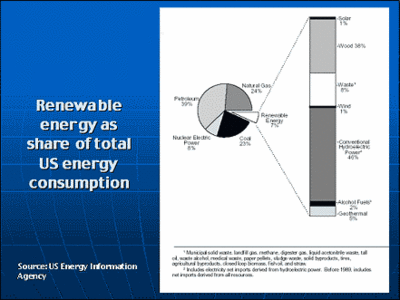I chose this slide for two reasons: One, it puts into perspective just how small the percentage of total US energy consumption solar and wind energy is. Two, it refers to a personal epiphany I had last night when I was researching the cost of "going solar." It could take up to $20K to put a couple of kilowatts up at our house. (Scrounging may take much less, but still.)
I put these two facts together and realized that solar is not a panacea. We really are going to have to cut our consumption down to the bone on an individual level and start a Manhattan-level project to develop renewable sources on the national level. Sobering. But please, read on...

Let's look at this as a pie graph. This little pie slice here, which represents between 6 and 7% of our total energy budget, that little slice is renewables. And if you expand that slice, you see that most of it is taken up with conventional hydroelectric power and wood, people heating their homes with wood, towns burning municipal waste for energy, and then there's a little in the way of alcohol fuels, and geothermal, and then wind makes up about 1%, and solar makes up about 1%.
Now we're not talking about 1% of the total energy pie, we're talking about 1% of this little slice. So if you add solar and wind together, currently we're getting 0.17% of our total energy budget from solar and wind combined.
Now why make a big deal out of that? Because solar and wind are two primary energy sources that we could grow. We can't grow hydroelectric production that much, because we've already dammed most of the rivers. We're not going to burn a heck of a lot more trees, because if we start doing that, then we'll run out pretty soon. Wood is renewable, but it's exhaustible.
We can produce more power from solar and wind, but look where we're starting from. If we were to double our total solar and wind capacity, what it is currently, what we've worked for 20 years to build up, if we were to double that, and that's not a small feat–and then if we were take that amount and double it again, we still wouldn't be up to 1% of our total national energy budget.
So what's required in order to make that piece of the pie grow significantly is not just a billion dollars here and there of seed money from the federal government. What's required is hundreds of billions of dollars a year in new investment, and the International Energy Agency acknowledges this.
In their recent report, they're anticipating, in order to meet our energy demands by 2030, we're going to have to increase our investment in energy production dramatically to something like 550 billion dollars a year globally, 16 trillion dollars by 2030, we're going to have to spend. And that is assuming that most of that investment will go to fossil fuel resources, and that's assuming that those resources will be there, to be found and developed.
So if we were to follow the IEA path, which basically is echoed by the industry itself–I was at this presentation by an executive of ExxonMobil a few weeks ago, who basically showed the same graphs and same expectations of growth and investment and so on–by 2030, we will be even more dependent on fossil fuels than we are now, and we will have spent $16 trillion to get there, and then what will we do? At that point, then we'll have to spend trillions more to develop an alternative renewable energy infrastructure to replace the fossil fuel infrastructure that is now obsolete because we've run out of oil and gas. It's insane. It's absolutely insane. And yet these are the responsible agencies telling us what we're about to do.
No comments:
Post a Comment